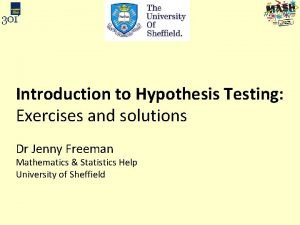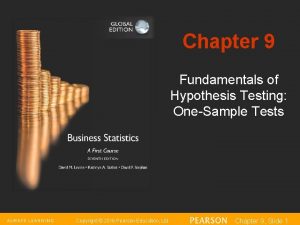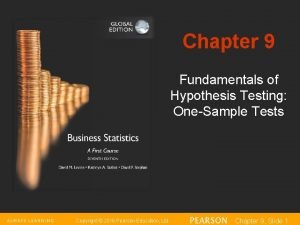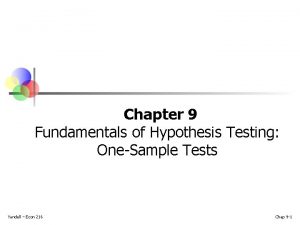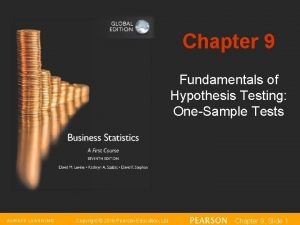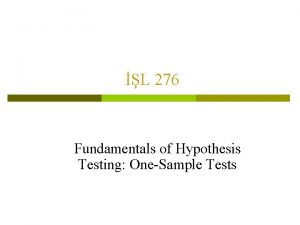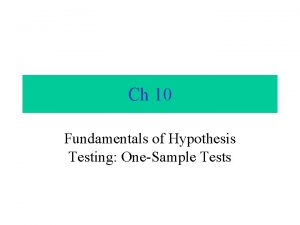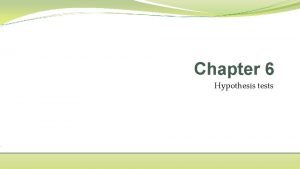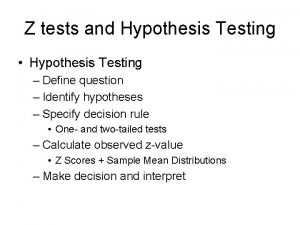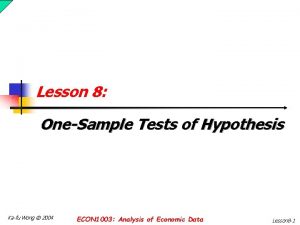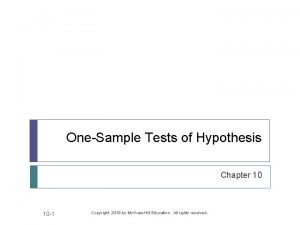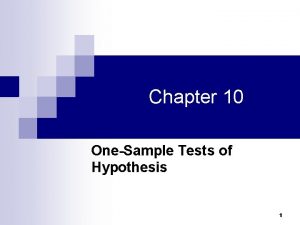OneSample Tests of Hypothesis Hypothesis and Hypothesis Testing













- Slides: 13

One-Sample Tests of Hypothesis

Hypothesis and Hypothesis Testing HYPOTHESIS A statement about the value of a population parameter developed for the purpose of testing. HYPOTHESIS TESTING A procedure based on sample evidence and probability theory to determine whether the hypothesis is a reasonable statement. TEST STATISTIC A value, determined from sample information, used to determine whether to reject the null hypothesis. CRITICAL VALUE The dividing point between the region where the null hypothesis is rejected and the region where it is not rejected.

Important Things to Remember about H 0 and H 1 l l l l l H 0: null hypothesis and H 1: alternate hypothesis H 0 and H 1 are mutually exclusive and collectively exhaustive H 0 is always presumed to be true H 1 is the research hypothesis A random sample (n) is used to “reject H 0” If we conclude 'do not reject H 0', this does not necessarily mean that the null hypothesis is true, it only suggests that there is not sufficient evidence to reject H 0; rejecting the null hypothesis then, suggests that the alternative hypothesis may be true. Equality is always part of H 0 (e. g. “=” , “≥” , “≤”). “≠” “<” and “>” always part of H 1 In actual practice, the status quo is set up as H 0 In problem solving, look for key words and convert them into symbols. Some key words include: “improved, better than, as effective as, different from, has changed, etc. ” Inequality Symbol Part of: Larger (or more) than > H 1 Smaller (or less) < H 1 No more than H 0 At least ≥ H 0 Has increased > H 1 Is there difference? ≠ H 1 Has not changed = H 0 Keywords Has “improved”, “is better than”. “is more effective” See left text H 1

Two-tailed Test Two-tailed tests - the Rejection rejection Region region is in both tails of the distribution One-tailed tests - the rejection region is in only on one tail of the distribution Acceptance Region Rejection Region One-tailed Test Rejection Region Acceptance Region

Types of Errors is true Reject Do not reject is false Type I error P(Type I)= Correct Decision Type II error P(Type II)= Type I Error Defined as the probability of rejecting the null hypothesis when it is actually true. This is denoted by the Greek letter “ ” Also known as the significance level of a test Type II Error: Defined as the probability of “accepting” the null hypothesis when it is actually false. This is denoted by the Greek letter “β”

Hypothesis Setups for Testing a Mean ( ) or a Proportion ( ) MEAN PROPORTION

Testing for a Population Mean with a Known Population Standard Deviation- Example EXAMPLE Jamestown Steel Company manufactures and assembles desks and other office equipment. The weekly production of the Model A 325 desk at the Fredonia Plant follows the normal probability distribution with a mean of 200 and a standard deviation of 16. Recently, new production methods have been introduced and new employees hired. The mean number of desks produced during last 50 weeks was 203. 5. The VP of manufacturing would like to investigate whethere has been a change in the weekly production of the Model A 325 desk, at 1% level of significance. Step 1: State the null hypothesis and the alternate hypothesis. H 0: = 200 H 1: ≠ 200 (note: This is a 2 -tail test, as the keyword in the problem “has changed”) Step 2: Select the level of significance. α = 0. 01 as stated in the problem Step 3: Select the test statistic. Use Z-distribution since σ is known Step 4: Formulate the decision rule. Reject H 0 if |Z| > Z /2 Step 5: Make a decision and interpret the result. Because 1. 55 does not fall in the rejection region, H 0 is not rejected. We conclude that the population mean is not different from 200. So we would report to the vice president of manufacturing that the sample evidence does not show that the production rate at the plant has changed from 200 per week.

Testing for a Population Mean with a Known Population Standard Deviation- Another Example Suppose in the previous problem the vice president wants to know whethere has been an increase in the number of units assembled. To put it another way, can we conclude, because of the improved production methods, that the mean number of desks assembled in the last 50 weeks was more than 200? Recall: σ=16, =200, α=. 01 Step 1: State the null hypothesis and the alternate hypothesis. H 0: ≤ 200 H 1: > 200 (note: This is a 1 -tail test as the keyword in the problem “an increase”) Step 2: Select the level of significance. α = 0. 01 as stated in the problem Step 3: Select the test statistic. Use Z-distribution since σ is known Step 4: Formulate the decision rule. Reject H 0 if Z > Z Step 5: Make a decision and interpret the result. Because 1. 55 does not fall in the rejection region, H 0 is not rejected. We conclude that the average number of desks assembled in the last 50 weeks is not more than 200

p-value in Hypothesis Testing l p-VALUE is the probability of observing a sample value as extreme as, or more extreme than, the value observed, given that the null hypothesis is true. l In testing a hypothesis, we can also compare the p-value to the significance level ( ). l Decision rule using the p-value: EAMPLE p-Value Recall the last problem where the hypothesis and decision rules were set up as: H 0: ≤ 200 H 1: > 200 Reject H 0 if Z > Z where Z = 1. 55 and Z =2. 33 Reject H 0 if p-value < 0. 0606 is not < 0. 01 Reject null hypothesis, if p< α Conclude: Fail to reject H 0

Testing for the Population Mean: Population Standard Deviation Unknown When the population standard deviation (σ) is unknown, the sample standard deviation (s) is used in its place and the t-distribution is used as test statistic, which is computed using the formula: EXAMPLE The Mc. Farland Insurance Company Claims Department reports the mean cost to process a claim is $60. An industry comparison showed this amount to be larger than most other insurance companies, so the company instituted cost-cutting measures. To evaluate the effect of the cost-cutting measures, the Supervisor of the Claims Department selected a random sample of 26 claims processed last month. The sample information is reported below. The sample mean was $56. 42 and sample standard deviation $10. 04. At the. 01 significance level is it reasonable a claim is now less than $60?

Testing for the Population Mean: Population Standard Deviation Unknown - Example Step 1: State the null hypothesis and the alternate hypothesis. H 0: ≥ $60 H 1: < $60 Step 2: Select the level of significance. α = 0. 01 as stated in the problem Step 3: Select the test statistic. Use t-distribution since σ is unknown Step 4: Formulate the decision rule. Reject H 0 if t < -t , n-1 Step 5: Make a decision and interpret the result. Because -1. 818 does not fall in the rejection region, H 0 is not rejected at the. 01 significance level. We have not demonstrated that the cost-cutting measures reduced the mean cost per claim to less than $60.

Tests Concerning Proportion using the z-Distribution l l l A Proportion is the fraction or percentage that indicates the part of the population or sample having a particular trait of interest. The sample proportion is denoted by p and is found by x/n It is assumed that the binomial assumptions are met: (1) the sample data collected are the result of counts; (2) the outcome of an experiment is classified into one of two mutually exclusive categories—a “success” or a “failure”; (3) the probability of a success is the same for each trial; and (4) the trials are independent Both n and n(1 - ) are at least 5. When the above conditions are met, the normal distribution can be used as an approximation to the binomial distribution The test statistic is computed as follows:

Test Statistic for Testing a Single Population Proportion - Example EXAMPLE Suppose prior elections in a certain state indicated it is necessary for a candidate for governor to receive at least 80 percent of the vote to be elected. A survey of 2, 000 registered voters revealed that 1, 550 planned to vote for the incumbent governor. Using the hypothesis-testing procedure, at 5% level, does the incumbent receives below 80% votes? Step 1: State the null hypothesis and the alternate hypothesis. H 0: ≥ 0. 80 H 1: < 0. 80 (note: This is a 1 -tail test as the keyword in the problem “below”) Step 2: Select the level of significance. α = 0. 05 as stated in the problem Step 3: Select the test statistic. Use Z-distribution since the assumptions are met and n(1 - ) ≥ 5 Step 4: Formulate the decision rule. Reject H 0 if Z < -Z Step 5: Make a decision and interpret the result. The computed value of z (-2. 80) is in the rejection region, so the null hypothesis is rejected at the. 05 level. The evidence at this point does not support the claim that the incumbent governor will get elected.
 ıniqlo
ıniqlo Positive vs negative testing
Positive vs negative testing Static testing and dynamic testing
Static testing and dynamic testing Hypothesis testing
Hypothesis testing How to find f stat
How to find f stat Domain testing in software testing methodologies
Domain testing in software testing methodologies Logic based testing
Logic based testing Data flow testing strategies in software testing
Data flow testing strategies in software testing Globalization testing in software testing
Globalization testing in software testing Functional testing vs unit testing
Functional testing vs unit testing Cause effect graph for triangle problem
Cause effect graph for triangle problem Control structure testing in software testing
Control structure testing in software testing Decision table testing in software testing
Decision table testing in software testing Decision table testing examples
Decision table testing examples



